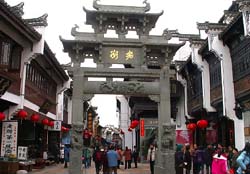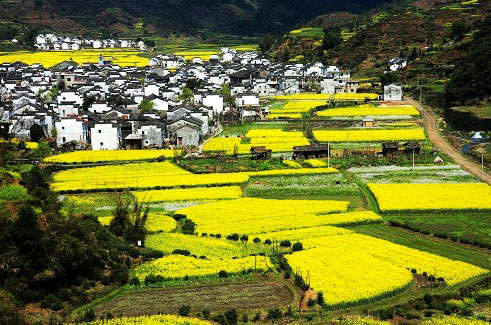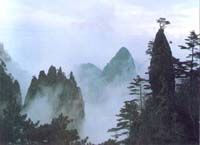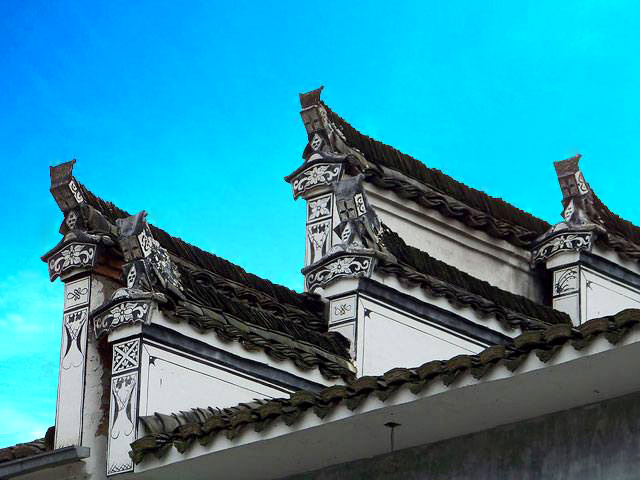| Day 1 Huangshan ( ) |
Upon your arrival, Our local guide will pick you up at the airport or train station, and escort you to the hotel for checking in. The rest of the day is all yours. You can stroll at the 500-year-old Tunxi Ancient Street to have a brief impression of the local life or just stay at the hotel for relaxation. |
Huangshan City | Huangshan city is a prefecture-level city centered around the Huangshan Mountains in southern Anhui province, China. Its urban area was originally the old town of Tunx, many old houses decorated in traditional style are well protected in downtown Huangshan and nearby surburb. |
|
 |
| [ Optional ] Hukaiwen Ink Factory: Ink Stone Factory is the most important part of "Four Treasures of the Study". Because of its solid texture, ink stone can be handed down from ancient times. The Ink Stone Factory in Hangshan is one of the most famous ink stone factories in China, where you can see the whole working process. |
|
| Day 2 Huangshan ( B,L ) |
Hiking duration: 5 hours, 10 km
Drive to Nanyuankou Pier and begin hiking along the attractive "painting scroll of streams and Mountains" Xin'an River. Different charms will come to your sight in different seasons. In the springtime when rape flowers bloom, all villages along the Xi'an River are colored in golden yellow; in autumn days chrysanthemums and oranges are vibrant.
During the hiking, if time permitted, you can drop by and visit local the local farmers' home or school. |
2-hour trekking along Xin'anjiang River | The Xin'anjiang River is a major waterway of vital importance to the local economy, shipping out timber and local agricultural products and transporting in salt and manufactured goods. Tunxi, Yuliang Town and Shendu in Shexian County along the river used to be bustling river ports in the old days. | Memorial Arches in Shexian | Paifang is an archway usually made of fine wood or stone,as memorial and decoration. Shexian county is famous as the "the Town of Paifang" and has thousands of arches scattered around. It is the best place to explore the social culture in China's feudal society. | Tunxi Ancient Street | The 832-meter-long Ancient Street in Tunxi was built in the Southern Song Dynasty. The street is lined on both sides with buildings in the Ming and Qing styles, and has become a commercial center. The buildings here are mainly brick and wooden structures topped by gray tiles, and decorated with wood…… |
|
 |
| [ Optional ] Chengkan Village: Chengkan village in Huizhou District, Anhui province is famous for the residential architecture of the Ming and Qing style. Baolun Hall in the Ancestral Temple of Luo's, built during the Jiaqing's reign, is a representative collection of typical Huizhou architecture. |
|
| Day 3 Huangshan ( B,L ) |
Start your journey to Mt. Huangshan, an UNESCO World Cultural and Natural Site. Drive about 1h from the city centre to Mt. Huangshan Scenic Area and then take a cable car from Yungu (Cloud Valley) Station to White Goose Ridge Station. Feast your eyes on the fabulous pines and bizarre rocks nearby Beginning-to-Believe Peak, Meng Bi Sheng Hua (Flowers Blooming from a Writing Brush) and Tuan Jie Pine (Unity Pine).
After lunch, get ready for a hiking to Lion Peak and West Sea Grand Canyon (halfway), the biggest and the best hiking area in Mt. Huangshan. let your soul get wild and eyes open wide. Also enjoy the glory of Mt. Huangshan sunset at Cloud Dispelling Pavilion and spend the night time on the mountain. |
Sunset on Huangshan Mountain | One of the best point for sunset photos is at the Cloud Dispelling Pavilion, many people wait here every day. Flying Stone is another choice. In fact, the best place differs from season to season. We recommend Xihai Grand Canyon, less people visit, but lots of places to choose. Ask our local tou…… | Huangshan Cable Car | To fully enjoy the beauty of Mt. Huangshan, you have to reach the peak areas. With the assistance of cable car, this is made much easier. Huangshan Scenic Area has developed cable car since 1986.How to choose the appropriate cable car among the three? It depends on the location of your hotel and you…… | Yellow Mountain | Sunrise on Huangshan Mountain is amazing, there are more spectacular mornings and in particular when there is fog, the view is magnificent, many granite peaks and rocks emerging out of clouds. It is undoubtedly China's most celebrated mountain for all its grandeur and beauty. |
|
 |
| [ Optional ] Xihai Grand Canyon: To visit Xihai Grand Canyon, recommend you to take the route from the north via Taiping, a cable car terminal that take passengers to Pine Forest Peak in the northwestern corner of the summit of Mount Huangshan. |
|
| Day 4 Huangshan ( B,L ) |
Get up early in the morning to catch the Mount Huangshan's magnificent sunrise (if weather permits). After breakfast, tour to Bright Peak and Flying Over Rock. Later take Yungu cable car down the moutain. After lunch, drive to visit Hongcun Ancient Village that lies at the foot of the Mt. Huangshan. The whole village, also the World Cultural Heritage Site and the place for shooting the movie of Crounching Tiger and the Hidden Dragon, is a perfect combo of natural contribution and human intelligence. Hui-style eaves, wood carvings are abundant.
In the late afternoon the tour ends and you'll be transferred to Huangshan airport for your next destination. |
Sunrise on Huangshan Mountain | One of the best point for sunrise is at the Begin-to-Believe Peak. You need to walk in darkness from Beihai Hotel for 30 minutes in the early morning. Another good point is at the Bright Summit Peak. | Hongcun Village | Hongcun Village: An ancient town over 800 years old leaning against Mt. Huangshan, it is folded in the fog of the Mt. which makes it look like a river and mountain picts. It enjoys the reputation of "The Chinese town in the pictures". Especially, the whole town distributes like a "cow", which made i…… |
|
 |
| [ Optional ] Xidi Village: In Xidi Village are 600 grand family mansions, earning it the moniker Ming (1368-1644) and Qing (1644-1911) Residence Museum. Xidi has two main streets with 99 alleys running out of them. During its heyday 90 drinking wells served the needs of its 10,000 villagers. Enclosed within the unified white-washed Horse Head Wall -- a southern China architectural style where the walls descend staircase style, following the angle of the roof -- all houses in the village are built of wooden beams, stone an |
|